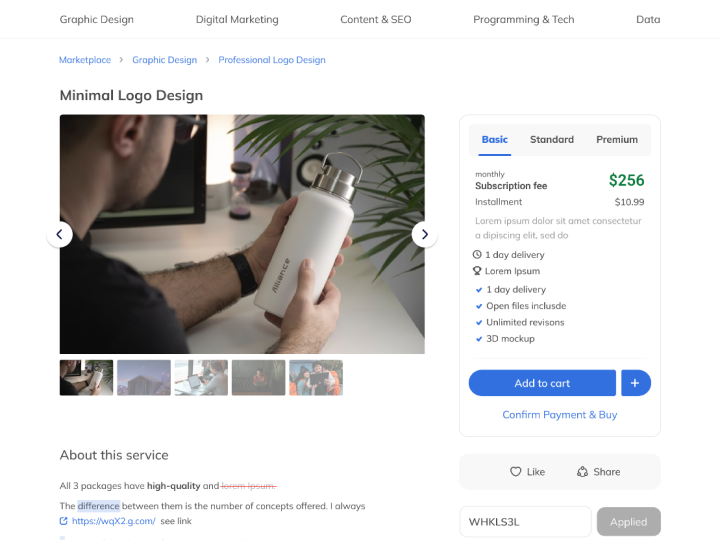Are you ready to unleash your creative genius and create a website to blow your competitors out of the water? Do you want to learn the techniques and principles of website design to create a stunning, professional, and highly functional website? If your answer is yes, then you are in the right place! This comprehensive beginner guide will help you design a visually appealing, user-friendly website that will envy your competitors. So, let’s get started! This guide will cover the basics of responsive web design, how to create a good web design and best practices for creating a successful website. With this guide, you’ll be able to tap into the power of web design and show the world what you’re truly capable of!

Before beginning the web design process, it is essential to know that it contributes to 75% of the business’s credibility – WebFX. With this guide, you’ll be one step closer to creating a website that will be the envy of your competitors. So, let’s get to it and have some fun while we’re at it!
What is Website Design?
This question may sound basic, but you must build your concepts with a strong foundation. Right? So let’s dive into the definition!
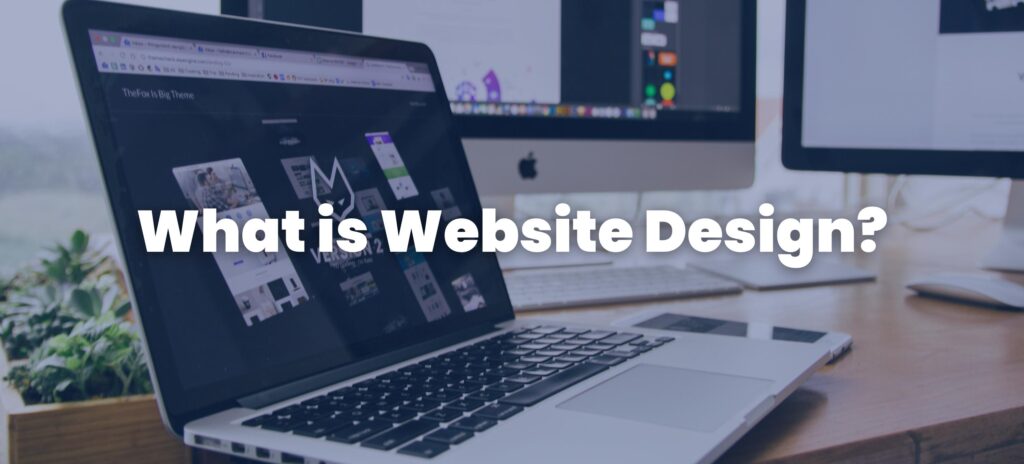
Website design is the process of planning, creating, and maintaining a website, considering its visual appearance, user experience, and functionality. It involves:
- Incorporating web design innovation
- Designing a website that is functional on different types of devices
- Creating a website that is visually attractive and user-friendly.
According to Virtual Window, 48% of users think web design is the main factor in deciding a business’s credibility.
Gaining the trust of customers is essential for any business to succeed. Achieving this goal starts with having a professional web design that instills confidence in visitors and encourages them to take the next step.
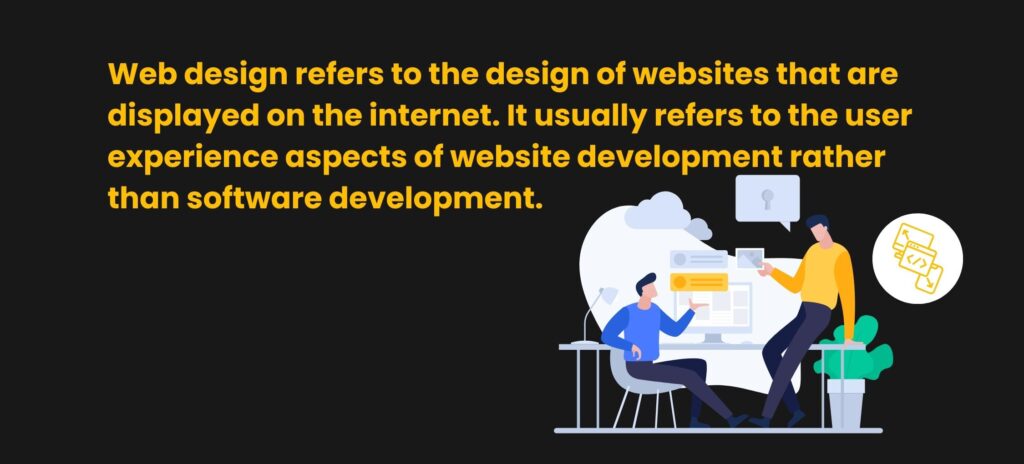
With the right web design strategies, you can create a website that will captivate your audience and give them a great experience.
Benefits of Web Design
When planning a website for your business, remember that web design can be the difference between success and failure.
94% of first impressions are related to your website’s design – Sweor. Remember that the first impression is the last! You can either make the visitors stay or lose them forever. Try prioritizing your web design to stay ahead of the curve! There are many benefits to investing in reliable web design and creating effective web pages.
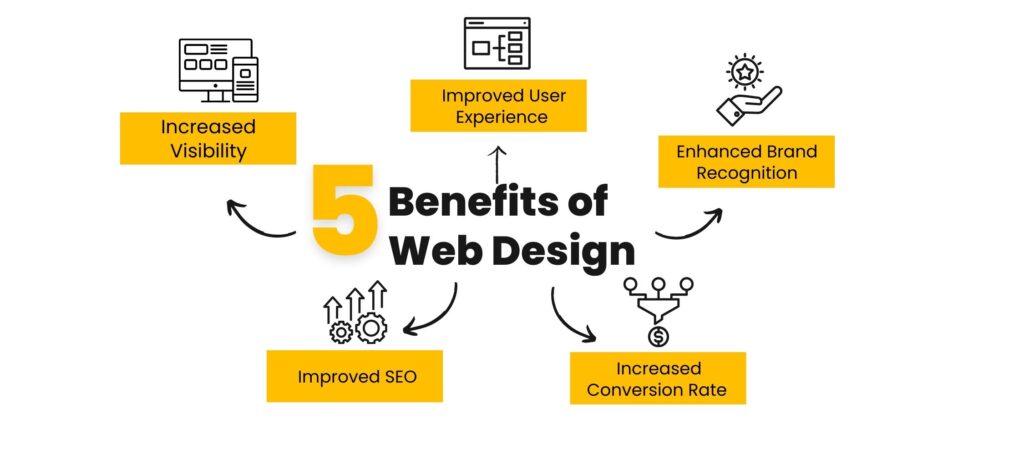
Following are just a few of the advantages of web design innovation:
- Improved User Experience: By utilizing intuitive design elements, you can create a website that is easy to use and navigate, leading to an improved user experience. It takes users just 0.05 seconds to form an opinion about your website – BloggingWizard. See how fast is the user’s analyzing power. A great design will lead to an excellent user opinion, ultimately increasing brand recognition.
- Increased Visibility: Creating a website with an eye-catching design can help your business stand out from the competition and increase its visibility.
- Enhanced Brand Recognition: Thoughtful web design can help build your brand identity and recognition. According to Zippia, 50% of consumers report that a company’s website is vital to the success of its overall brand. 50% of your brand’s success depends on your website’s design!
- Increased Conversion Rate: With an effective web design, your website will likely convert visitors into customers. One of the top reasons behind redesigning a website is the “low conversion rate.”That’s why you should create a commendable website design in the first attempt to save yourself from multiple redesigns!
- Improved SEO: Good web design can improve your website’s SEO and help you rank higher in search engine results pages.
Quality Website Design
Quality website design is essential for building a successful website that attracts visitors. 59% of the public prefer browsing ‘beautiful and well-designed sites to basic ones – Adobe. Crafting a top-notch website requires creativity and staying ahead of the curve by knowing the latest web design trends. I’m sure you’ll be simultaneously excited and confused by this moment! But don’t worry, as in this guide; you’ll learn all the essential principles of web design and the strategies you need to create a website that will make an impact. By harnessing the power of website design, you’ll be able to design a website that is functional, beautiful, and a joy to use.
What Makes a Good Website?
Creating a good website is about more than just having good visuals and how well it functions. To create a successful website, you need to understand the fundamentals of web design and apply some techniques and principles to make it user-friendly and visually appealing. You can create a website that kicks the competition barriers and captivates your users with the right website design techniques.
By landing here, you have taken your first step towards creating a highly functional yet creative website. Stay with us to know all the details you’ve been longing for!
Features of Web Design
From the concept of web design to website creation, web design innovation is essential for success. Here are some features of web design to consider when designing a website:
- User Experience: Ensure the website is easy to use and navigate.
- Responsive Design: The website should be accessible on all devices.
- Graphics & Visuals: Create visuals that draw attention and make a statement.
- SEO Optimization: Optimize the website for search engine visibility.
- Content: Create engaging and informative Content that resonates with users.
- Security: Ensure the website is safe and secure from potential hackers.
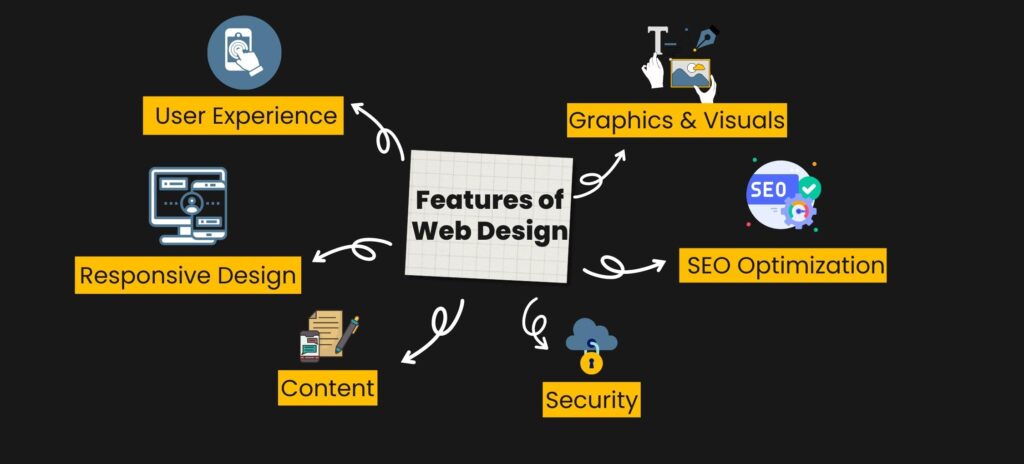
With these features in mind, you can launch a website that stands out from the competition!
Guidelines for Website Design
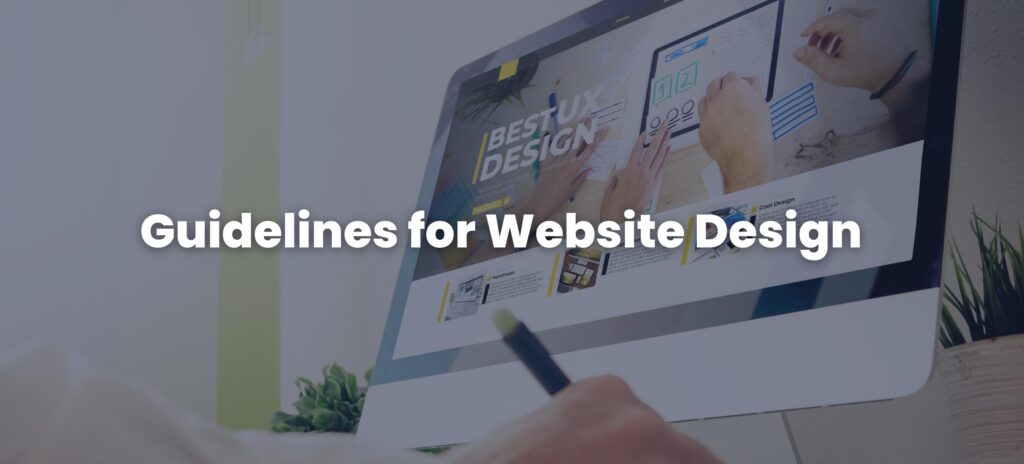
Whether creating a website from scratch or giving an existing one a makeover, you’ll need to know the basics of web design to ensure your website is successful. The following are some essential points to consider when designing your website:
- Understand who will use your website and create a design that meets their needs.
- Focus on visuals; they are essential to any web design and can help capture your audience’s attention.
- Ensure your website design is consistent and all elements are correctly aligned.
- What makes an effective web design is usability. Test your plan to make sure it is user-friendly.
- Use the latest web design tools and technologies to create a cutting-edge website.
- Let your creativity shine through with unique and innovative design elements.
- Test your website regularly to ensure it functions correctly and has no errors.
- Monitor the performance of your website to ensure it is running smoothly and efficiently.
- Keep the information on the latest trends in web design and incorporate them into your website.
Don’t Ignore “The Why” Behind The Design!
Regarding website design, it’s not just about “the how” . You need to understand “the why” behind it. To craft a website that is both visually stunning and user-friendly, you need to know the following:
- Why you’re designing a website?
- The key characteristics of a good website
- The elements that contribute to a successful design
These brainstormers will enable you to craft a visually stunning and user-friendly website. It’s vital to recognize the purpose of website design to create an innovative, engaging website that represents your brand and meets all your objectives. With this knowledge, you can unlock the power of website design and create something truly remarkable.
Website Design Principles
Hey! We have reached that section we’ve been waiting for so long. Yes, the one that is the crux of this blog. Are you ready to dive into the innovative world of website design and learn the principles that will help you create a successful website? Understanding website design principles is essential for crafting a creative and attractive website. Website design principles are divided into two categories:
- Visual web design principles
- Technical web design principles.
This section will explore these principles in depth and examine the importance of creating a user-friendly and responsive website. We’ll cover topics such as typography, color theory, and layout. You’ll learn to use these elements to create a unique stunning website. So, let’s get started and unlock the power of website design!
Visual Website Design Principles
Visual website design principles are the foundation of any good website design. They involve using certain elements, such as color, layout, typography, and imagery, to create an aesthetically pleasing and user-friendly website. Let’s look at these significant chunks of a great web design!
1. Achieve Simplicity for Maximum Impact
Simplicity is the key to a good website design. A simple website design is often more effective than a complex one. According to 84.6% of web designers, crowded web design is the most common glitch made by small businesses – GoodFirms. By focusing on simplicity, you can create a website that’s easy to use and navigate and packs a big punch in terms of impact.
2. Establish Consistency for Easier Usage
Consistency is essential for successful website design. Establish a consistent style for text, colors, images, and navigational elements and use them across all website pages. This strategy will make it easier for users to navigate and utilize the website.
3. Ensure Readability with Appropriate Typography
Good typography is essential to creating a successful website. 61.5% of website designers used expressive typography – GoodFirms. Use only legible fonts and ensure they are large enough and easy to understand. This approach will make your website more readable and easier to use.
4. Make Your Website Adaptable and Mobile Friendly
It’s essential to ensure your website is responsive and functional on any device. It is important to note that your website should be mobile-friendly with a great user experience. 61% of internet users have a higher opinion of companies with mobile-friendly website designs – WebFX. Over 50% declare they are less likely to engage with bad mobile-friendly website designs – ThinkWithGoogle

5. Create a Cohesive Visual Experience with the Right Colour Palette and Imagery
A good website design should have a cohesive visual experience throughout. Create a color palette and imagery that ties all the pages together and makes the website look more unified and professional. 39% of web users are drawn to color more than any other visual element when visiting sites – topdesignfirms. Try using an appropriate color and combinations of different colors to make your website more attractive!
6. Make Your Website Load Fast
Website loading speed is essential in website design. Optimize your website for speed and performance to ensure users have a positive experience. Reducing your website load speed from 8 to 2 seconds can boost your conversion rate by up to 74% – SAG ipl. The impact of a website’s loading speed is powerful on revenue. On the other hand, websites that load slowly lead to a $2.6 billion loss in revenue every year – Web FX. A fast-loading website holds this much significance in generating your company’s revenue!
7. Make Navigation Effortless and Straightforward
Clear and intuitive navigation is essential for successful website design. Users spend around 6 seconds looking at the navigation bar – BloggingWizard. Ensure easy-to-use navigation options to help users quickly find the information they need.
8. Keep Communication Open
Good communication with your users is essential for successful website design. Make sure to provide an easy way for users to contact you with questions and feedback.
9. Focus on High Quality and Credibility
Quality is vital in website design. Ensure your website looks professional and credible by focusing on high-quality design and Content.
10. Design for Scannability
Most people need to read website content word for word. Instead, they scan the page for essential information. Make sure to design your website with scannability to make it compatible for users to find the information they need. You can prefer using more high-quality images on your site than the Content, as Images hold user attention for around ½ a second longer than text – BloggingWizard. In this way, viewers can easily find the relevant information instead of reading the whole Content, making the site scannable!
11. Highlight Features and Benefits
A good website design should highlight the features and benefits of your product or service. Make sure to include a section on your website that clearly outlines the features and benefits of the product or service.
12. Utilize Whitespace to Enhance the Design
Whitespace is essential to website design. Use whitespace to create a visual hierarchy, draw attention to critical elements, and make the overall design more appealing.
13. Keep it Economical
Website design can be expensive, but it doesn’t have to be. Keep it economical by focusing on essential elements and avoiding unnecessary features. Focus on the following strategies:
- Focus on Clarity and Conciseness: Clarity and conciseness are essential for successful web design. Ensure the use of simple language and avoid clutter to ensure your website is easy to use and understand.
- Make it Distinctive and Unique: Make sure your website stands out from the competition by making it distinctive and unique. Use creative design elements and original Content to make your website stand out.
- Utilize Emphasis for Visual Impact: Emphasis can draw attention to critical elements and make your website more visually appealing. Make sure to use emphasis strategically to create a more engaging web design.
14. Employ Conventional Design Guidelines
Conventional design guidelines can be helpful when creating a website. Follow the best practices and procedures for web design to ensure your website looks professional and functions appropriately.
15. Test Your Design for Usability
Usability testing is integral to website design. Test your website for usability to ensure it’s easy to use and navigate.
16. Guide User Attention with Visual Cues
Visual cues guide user attention and ensure they find the necessary information. Users spend 88% more time on pages with videos – WebFX, and large, high-quality images are the most appealing – BloggingWizard. Use visual cues to draw attention to critical elements and make your website more accessible.
17. Limit the User’s Inputs
Keep user inputs to a minimum to make the website more user-friendly. Ensure limiting user requirements and keeping the user experience simple.
18. Make the Design Self-Explanatory
The design of your website should be self-explanatory. Make sure to create a plan that’s intuitive and easy to understand.
19. Leverage the F-Shaped Pattern Reading
F-shaped pattern reading is a popular way of scanning and reading web pages. Make sure to design your website with an F-shaped pattern to ensure users can easily find the information they need.
20. Construct a Logical Visual Hierarchy
A logical visual hierarchy is essential for successful web design. Make sure to create a visual order that organizes the Content intuitively and logically.
21. Put Content at the Forefront
Content should always be the focus of website design. Keep Content at the forefront of your innovation and focus on creating an engaging and informative user experience. According to WebFX, 38% of users will leave a page if its layout or Content needs to be more attractive. Content and visual elements should be equally important to you to get a commendable result.
22. Use Grid-Based Layouts
Grid-based layouts are a popular and effective way to organize website content. Use a grid-based layout to make your website look more organized and professional.
Technical Website Design Principles
It’s essential to understand the technical website design principles that will help you create a website that functions well and is easy to use. Responsive web design principles are crucial to building a website that looks exceptional on any device and loads quickly. Understanding these principles can help you create a website that looks professional, functions efficiently, and is easy for your users to navigate. With this knowledge, you can create a unique website and impress your visitors! Let’s dive into the technical strategies to uplift your website’s potential!
1. Optimize for Search Engines
Optimize your website for search engines to rank higher and increase organic traffic. This strategy contributes excellent value to a website.
2. Encrypt Data for Security
Ensure data encryption is a part of your website design. It helps protect user data and keep your website secure.
3. Always Include a Clear Call to Action
Include a clear call to action to guide users through your website and encourage them to take the desired action. 7 out of 10 small business websites do not include a call to action – SmallBizTrends on their website, which results in a loss of conversions!
4. Make Contact and Location Information Easily Accessible
Make your contact and location information accessible to help customers find and reach you more easily.
51% of people think “proper contact information” is the most crucial element missing from many companies websites– hubspot. Try not to be on the list of that 51%.
5. Ensure Browser Compatibility
Ensure your website is compatible with different browsers to provide a good user experience and reach a wider audience.
6. Ensure Secure Forms
Secure your website forms with SSL encryption to keep user data safe and secure.
7. Optimize for Performance
Optimize your website for performance to improve the speed and usability of your website and provide a better user experience. 76% of users say ease of use is essential in web design – Hubspot. Keep the user experience in mind while focusing on the plan to gain the most productive results!
8. Implement Semantic Markup
Use semantic markup to help search engines recognize it and improve your website’s SEO.
Uncovering Inspiration for Website Design
Now that you’ve mastered web design principles, you must seek inspiration to get started. Finding inspiration for your website design can be a daunting task. But don’t worry! There are lots of great sources of inspiration out there. Look at popular websites in your industry or niche and see what catches your eye. Check out design blogs, design galleries, and portfolios to get ideas for website layouts and features. By exploring different sources of inspiration, you’ll be able to uncover new and innovative ways to build a website that outstands the crowd.
Exploring the Top Web Design Trends of 2023
Are you curious to explore the top web design trends of 2023? What are the most popular web design trends this year? Look no further! In this section, we’ll explore the top web design trends of 2023, from innovative website design techniques to the latest advances in creating a website. With this guide, you’ll have the knowledge and insight to stay ahead of the curve and build a website that outdoes the competition. So, let’s explore the top web design trends of 2023!
Exploring Parallax Scrolling
Parallax scrolling is a trend gaining traction in the web design world.It creates a 3D effect and adds depth to web pages by making foreground elements move faster than background elements. This eye-catching effect is sure to bring an element of surprise and delight to your website.
Enhancing User Experience with Chatbot
Chatbot Integration is becoming increasingly popular in web design as they provide visitors with an interactive, conversational experience. 68% of users enjoy the speed at which chatbots answer – Userlike. Chatbots can help to answer questions, provide customer service, and even direct users to the right page on your website.
Voice-Activated User Interface
Voice-activated interfaces are quickly becoming one of the top-rated web design trends. They allow users to interact with your website using voice commands, making the user experience more natural and intuitive.
Exploring Virtual Reality in Web Design
Virtual reality is a powerful web design trend that can innovate how to interact with websites. It creates immersive, interactive experiences that engage visitors and draws them into the website.
Micro Interactions and Micro Animations for Improved User Experience
Micro-interactions and animations are becoming increasingly popular in web design as they provide an engaging and visually appealing experience. They draw attention to specific elements on a page and make interactions more intuitive.
Incorporating Smart Videos into Web Design
Smart videos are a compelling web design trend that creates an engaging and interactive visitor experience. They provide educational content or create an interactive shopping experience. Photos/images (40%), color (39%), and videos (21%) are the top visual elements consumers appreciate in web design – topdesignfirms. Visitors enjoy scanning more than reading, so try integrating animations, illustrations, and eye-catching elements on your website to increase engagement.
Essential Questions to Ask Before Crafting a Website Design
Before crafting a website design, asking yourself some basic questions is important.
- What will be the primary goal of the website design?
- Who is the target audience?
- What Content and features will the design contain?
- How will the website design be structured?
- What design style to opt for on the website?
- What type of navigation will be used to facilitate the website design?
- What will be the primary call to action?
- What type of hosting is needed to support the website design?
- What type of analytics should be used to measure the website design?
- How will the web design be tested for effectiveness?
- How will the website design be maintained for optimal performance?
Answering these questions will help you create an effective web design that meets your needs. With the right plan, you’ll be well on your way to creating an optimal website.
Making Use of the Latest Technologies
The latest web design technologies include HTML, CSS, JavaScript, PHP, Python, and React. These technologies are fundamental to creating a modern, functional website. Additionally, they provide users with a dynamic, interactive experience. Furthermore, leveraging frameworks such as Bootstrap and Foundation can help you quickly prototype and develop a website. Finally, using content management systems such as WordPress and Hubspot CMS will enable you to quickly and easily create and manage Content for your website.
Analyzing Your Design Performance
Understanding how your web design is performing is vital to unlocking the full potential of your website.
By analyzing the performance of your design, you can:
- Identify areas for improvement
- Optimize your design for a better user experience
- Make decisions that will maximize the impact of your website.
Analyzing your design performance also helps you understand the usability and adaptability of your site to users’ needs. Analyzing your design performance will ensure that your website achieves its goals and stays ahead of the competition.
Measuring the Success of Your Website Design
To ensure that your web design is successful, it’s essential to measure the success of the design. You can do this by analyzing the following:
- The Page Views
- Bounce Rate
- User Engagement
- User Experience.
Also, consider monitoring the website’s performance to identify any areas of improvement. Tracking user behaviors and data will help you understand what works and doesn’t. Additionally, consider testing different website design strategies to find the most effective for your website. Regularly evaluating your web design ensures that your website is successful and meets your goals.
Summary
Website design is more than just creating visually appealing websites. It involves understanding the principles and techniques of design and how to use these to create an effective website. Following the tips and advice outlined in this guide, you can begin to harness the power of web design to create engaging and successful websites.
Takeaways
In conclusion, website design is a powerful tool that can help you create a website that looks great and is user-friendly. By learning the principles and techniques of website design, you can create a website that looks professional and is easy to navigate. The tips outlined in this guide can help you unleash the power of website design and develop effective websites that will attract visitors and generate leads. Following the latest web design trends can quickly strengthen your brand recognition and help you stay ahead!
If you still need clarification about designing your site, no worries! Our expert UI/UX designers will guide you through the process. If you want us to apply all these principles to your website’s design, you can contact us right away!





 Unlock the Limitless Possibilities of Chat GPT: ..
Unlock the Limitless Possibilities of Chat GPT: .. Unlock the Magic of Artificial Intelligence Stor..
Unlock the Magic of Artificial Intelligence Stor.. Chatbot Marketing: Ignite Your Digital Marketing..
Chatbot Marketing: Ignite Your Digital Marketing..

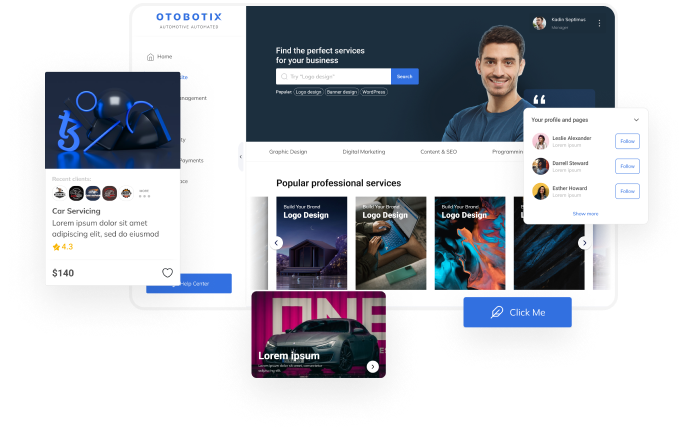






.png)
